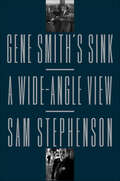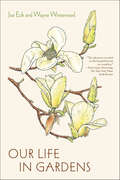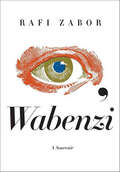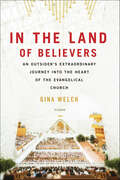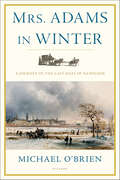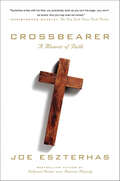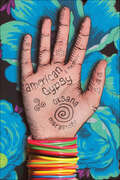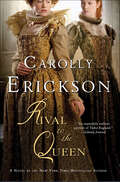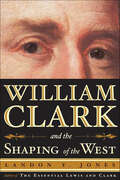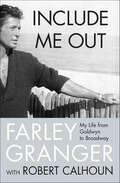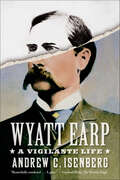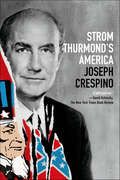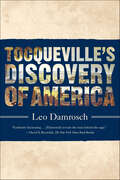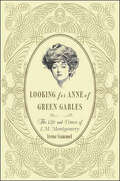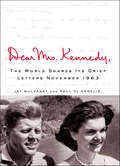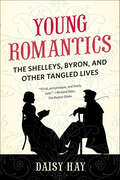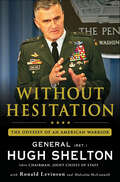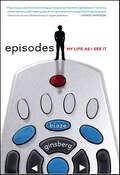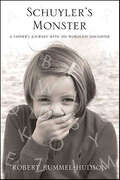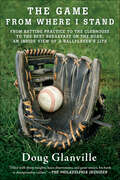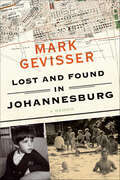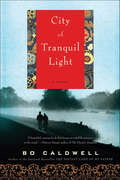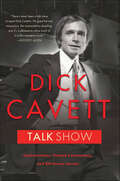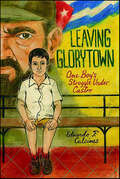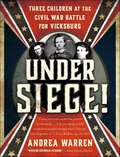- Table View
- List View
Gene Smith's Sink: A Wide-Angle View
by Sam StephensonAn incisive biography of the prolific photo-essayist W. Eugene SmithFamously unabashed, W. Eugene Smith was photography’s most celebrated humanist. As a photo essayist at Life magazine in the 1940s and ’50s, he established himself as an intimate chronicler of human culture. His photographs of war and disaster, villages and metropolises, doctors and midwives, revolutionized the role of images in journalism, transforming photography for decades to come.When Smith died in 1978, he left behind eighteen dollars in the bank and forty-four thousand pounds of archives. He was only fifty-nine, but he was flat worn-out. His death certificate read “stroke,” but, as was said of the immortal jazzman Charlie Parker, Smith died of “everything,” from drug and alcohol benders to weeklong work sessions with no sleep.Lured by the intoxicating trail of people that emerged from Smith’s stupefying archive, Sam Stephenson began a quest to trace his footsteps. In Gene Smith’s Sink, Stephenson merges traditional biography with rhythmic digressions to revive Smith’s life and legacy. Traveling across twenty-nine states, Japan, and the Pacific, Stephenson profiles a lively cast of characters, including the playwright Tennessee Williams, to whom Smith likened himself; the avant-garde filmmaker Stan Brakhage, with whom he once shared a Swiss chalet; the artist Mary Frank, who was married to his friend Robert Frank; the jazz pianists Thelonious Monk and Sonny Clark, whose music was taped by Smith in his loft; and a series of obscure caregivers who helped keep Smith on his feet. The distillation of twenty years of research, Gene Smith’s Sink is an unprecedented look into the photographer’s potent legacy and the subjects around him.
Our Life in Gardens
by Joe Eck Wayne WinterrowdThis is the third book we have written together, though separately we have written others . . . But to say ‘written separately' makes no sense, for when two lives have been bent for so many years on one central enterprise—in this case, gardening—there really is no such thing as separately." With these words, the renowned garden designers Joe Eck and Wayne Winterrowd begin their entertaining, fascinating, and unexpectedly moving book about the life and garden they share. The book contains much sound information about the cultivation of plants and their value in the landscape, and invaluable advice about Eck and Winterrowd's area of expertise: garden design. There are chapters about the various parts of their garden, and sections about particular plants—roses and lilacs, snowdrops and cyclamen—and vegetables. The authors also discuss the development of their garden over time, and the dark issue that weighs more and more on their minds: its eventual decline and demise. Our Life in Gardens is a deeply satisfying perspective on gardening, and on life.
I, Wabenzi: A Souvenir
by Rafi ZaborSome time ago Rafi Zabor sat down to write a brief narrative of the year 1986. That was the year he set out across two continents in a used Mercedes--"Wabenzi" is the Swahili word for a member of the Mercedes-owning class--to buy a grave stone for his friend Mahmoud Rauf and to outrun the shadow of his own parents' recent death.But like a boat against the current, the writer was drawn back into the past: his father's escape from the Nazis, Rafi's own Brooklyn boyhood surrounded by the fractious, Zabors and Zaborovskys, and the anguished--sometimes farcical--spiritual journey that led Zabor from Brooklyn to Turkey by way of Coltrane, the thirteenth-century mystic Muhyiddin Ibn ‘Arabi, the McGovern campaign, Gurdjieff, a shoe salesman named Gogol, and the cataclysmic months Zabor spent studying (and whirling) amid a band of Sufis in rural England. The result--the first of a projected four volumes--is one of the most original, capacious, and vivid narratives of the last few decades, a real-life Bildungsroman dealing with an expanded range of human experience, from matters of life and death to a piece of what lies beyond them. Straight from the unchartered territory between Zen and the Art of Motorcycle Maintenance and Tristram Shandy, I, Wabenzi lifts a corner of the known world as if it were the edge of a curtain, and begins to show a reality new to our literature gleaming on the other side.
In the Land of Believers: An Outsider's Extraordinary Journey into the Heart of the Evangelical Church
by Gina WelchAn undercover exploration of the world of evangelicals, offering an extraordinary behind-the-scenes look at the faithfulEver since evangelical Christians rose to national prominence, mainstream America has tracked their every move with a nervous eye. But in spite of this vigilance, our understanding hasn't gone beyond the caricatures. Who are evangelicals, really? What are they like in private, and what do they want? Is it possible that beneath the differences in culture and language, church and party, we might share with them some common purpose?To find out, Gina Welch, a young secular Jew from Berkeley, joined Jerry Falwell's Thomas Road Baptist Church. Over the course of nearly two years, Welch immersed herself in the life and language of the devout: she learned to interpret the world like an evangelical, weathered the death of Falwell, and embarked on a mission trip to Alaska intended to save one hundred souls. Alive to the meaning behind the music and the mind behind the slogans, Welch recognized the allure of evangelicalism, even for the godless, realizing that the congregation met needs and answered questions she didn't know she had. What emerges is a riveting account of a skeptic's transformation from uninformed cynicism to compassionate understanding, and a rare view of how evangelicals see themselves. Revealing their generosity and hopefulness, as well as their prejudice and exceptionalism, In the Land of Believers is a call for comprehending, rather than dismissing, the impassioned believers who have become so central a force in American life.
Mrs. Adams in Winter: A Journey in the Last Days of Napoleon
by Michael O'BrienEarly in 1815, Louisa Catherine Adams and her young son left St. Petersburg in a heavy Russian carriage and set out on a difficult journey to meet her husband, John Quincy Adams, in Paris. She traveled through the snows of eastern Europe, down the Baltic coast to Prussia, across the battlefields of Germany, and into a France then experiencing the tumultuous events of Napoleon's return from Elba. Along the way, she learned what the long years of Napoleon's wars had done to Europe, what her old friends in the royal court in Berlin had experienced during the French occupation, how it felt to have her life threatened by reckless soldiers, and how to manage fear.The journey was a metaphor for a life spent crossing borders: born in London in 1775, she had grown up partly in France, and in 1797 had married into the most famous of American political dynasties and become the daughter-in-law of John and Abigail Adams.The prizewinning historian Michael O'Brien reconstructs for the first time Louisa Adams's extraordinary passage. An evocative history of the experience of travel in the days of carriages and kings, Mrs. Adams in Winter offers a moving portrait of a lady, her difficult marriage, and her conflicted sense of what it meant to be a woman caught between worlds.
Crossbearer: A Memoir of Faith
by Joe EszterhasJoe Eszterhas grew up in refugee camps and then in America's back alleys. He worked as a police reporter, racing the cops to robberies and shootings. He interviewed and wrote about mass murders and serial killers. He wrote dark, sexually graphic, and violent films like Basic Instinct, Jagged Edge, and Jade.Eszterhas knew a lot about darkness. Then, on a hellishly hot day in 2001, desperately battling to survive throat cancer and his addictions to alcohol and cigarettes, Joe Eszterhas found God. Or God found him.And he came from darkness into light.Crossbearer is the powerful, poignant, and sometimes wryly humorous account of a streetwise and cynical man's newfound faith, and of how he discovers God in the most intimate and routine moments of life: a family game of baseball, a child's photograph of a cloud, a dying mother's dying roses.It is also the inspiring story of a man who must overcome his addictions to stay alive—and can't by himself. He realizes that he needs the love of his wife, his children, and especially his new friend, God, to do it.Eszterhas is a master memoirist—his Hollywood Animal was called "powerful and affecting" (The New York Times), "absolutely first-rate" (Los Angeles Times BookReview) and "heartbreaking, funny and outrageous" (Houston Chronicle)—and with Crossbearer he reveals a fresh and completely unexpected new chapter of his life. With surprising tenderness and a willingness to bare even weaknesses and mistakes, Joe Eszterhas has written a startling personal story about faith, values, family and love.
American Gypsy: A Memoir
by Oksana MarafiotiA vivid and funny memoir about growing up Gypsy and becoming AmericanFifteen-year-old Oksana Marafioti is a Gypsy. This means touring with the family band from the Mongolian deserts to the Siberian tundra. It means getting your hair cut in "the Lioness." It also means enduring sneering racism from every segment of Soviet society. Her father is determined that his girls lead a better, freer life. In America! Also, he wants to play guitar with B. B. King. And cure cancer with his personal magnetism. All of this he confides to the woman at the American embassy, who inexplicably allows the family entry. Soon they are living on the sketchier side of Hollywood.What little Oksana and her sister, Roxy, know of the United States they've learned from MTV, subcategory George Michael. It doesn't quite prepare them for the challenges of immigration. Why are the glamorous Kraft Singles individually wrapped? Are the little soaps in the motels really free? How do you protect your nice new boyfriend from your opinionated father, who wants you to marry decently, within the clan?In this affecting, hilarious memoir, Marafioti cracks open the secretive world of the Roma and brings the absurdities, miscommunications, and unpredictable victories of the immigrant experience to life. With unsentimentally perfect pitch, AmericanGypsy reveals how Marafioti adjusted to her new life in America, one slice of processed cheese at a time.
Rival to the Queen: A Novel
by Carolly Erickson“An exquisitely realistic portrait of Tudor England” sets the stage for royal romantic rivalry in this “compelling” novel from a New York Times bestseller (Library Journal).From the New York Times–bestselling author of The Last Wife of Henry VIII comes a novel about the rivalry between Queen Elizabeth I and her cousin, Lettice Knollys, for the love of one extraordinary man.Powerful, dramatic and full of the rich history that has made Carolly Erickson’s novels perennial bestsellers, this is the story of the only woman to ever stand up to the Virgin Queen—her own cousin, Lettie Knollys. Far more attractive than the queen, Lettie soon won the attention of the handsome and ambitious Robert Dudley, Earl of Leicester, a man so enamored of the queen and determined to share her throne that it was rumored he had murdered his own wife in order to become her royal consort. The enigmatic Elizabeth allowed Dudley into her heart, and relied on his devoted service, but shied away from the personal and political risks of marriage.When Elizabeth discovered that he had married her cousin Lettie in secret, Lettie would pay a terrible price, fighting to keep her husband’s love and ultimately losing her beloved son, the Earl of Essex, to the queen’s headsman.This is the unforgettable story of two women related by blood, yet destined to clash over one of Tudor England’s most charismatic men.“Rival to the Queen gives this forgotten woman a place in history.” —RT Book Reviews“If you are a fan of Carolly Erickson or historical fiction, this book is for you.” —Affaire de Coeur“Erickson writes gracefully.” —Publishers Weekly
William Clark and the Shaping of the West
by Landon Y. JonesBetween 1803 and 1806, Meriwether Lewis and William Clark co-captained the most famous expedition in American history. But while Lewis ended his life just three years later, Clark, as the highest-ranking Federal official in the West, spent three decades overseeing its consequences: Indian removal and the destruction of Native America. In a rare combination of storytelling and scholarship, best-selling author Landon Y. Jones presents for the first time Clark's remarkable life and influential career in their full complexity.Like every colonial family living on Virginia's violent frontier, the Clarks killed Indians and acquired land; acting on behalf of the United States, William would prove successful at both. Clark's life was spent fighting in America's fifty-year running war with the Indians (and their European allies) over the Western borderlands. The struggle began with his famed brother George Roger's western campaigns during the American Revolution, continued through the vicious battles of the War of 1812, and ended with the Black Hawk War in the 1830s. In vividly depicting Clark's life, Jones memorably captures not only the dark and bloody ground of America's early West, but also the qualities of character and courage that made him an unequalled leader in America's grander enterprise: the shaping of the West. No one played a larger part in that accomplishment than William Clark. William Clark and the Shaping of the West is an unforgettable human story that encompasses in a single life the sweep of American history from colonial Virginia to the conquest of the West.
Include Me Out: My Life from Goldwyn to Broadway
by Farley Granger Robert CalhounThe star of Hitchcock’s Rope and Strangers on a Train “recalls life onstage and in film in an engaging, colorful memoir” (Kirkus Reviews, starred review).Synonymous with the golden age of Broadway, the dazzling lights of Hollywood, and the rise of television arts, Farley Granger’s charm and talent captivated the acting community and audiences alike. Working with creative visionaries like Alfred Hitchcock, Luchino Visconti, and Nick Ray, Granger was a celebrated figure in films like Strangers on a Train, Rope, Senso, and They Live by Night, bringing to the big screen a stunningly memorable presence.But behind his characters, he was an intensely complex man. In his richly told memoir, Granger details his life with disarming candor. Rich in personal insight, he describes his relationships with both men and women and reminisces about legends he knew with private familiarity—from Shelley Winters and Joan Crawford to Leonard Bernstein and Tyrone Power.Recreating not only his personal struggles but his legendary struggle to free himself of his contract with Sam Goldwyn, Granger reveals none so elegantly as he does himself. Include Me Out is as much a story of classic Hollywood glamour as it is a collection of iconic theatrical portraits, all from the man who knew them all.“This polished and perceptive memoir etches a scintillating portrait of life inside Tinseltown soundstages where ‘nothing was real except anxiety, insecurity and fear’ . . . The book has a huge celebrity cast, from Mike Todd, Rita Hayworth and Cornelia Otis Skinner to Leonard Bernstein and Peggy Guggenheim. Granger and Calhoun write with a stylish and iridescent flair.” —Publishers Weekly
Wyatt Earp: A Vigilante Life
by Andrew C. IsenbergFinalist for the 2014 Weber-Clements Book Prize for the Best Non-fiction Book on Southwestern AmericaIn popular culture, Wyatt Earp is the hero of the Gunfight at the O.K. Corral in Tombstone, Arizona, and a beacon of rough cowboy justice in the tumultuous American West. The subject of dozens of films, he has been invoked in battles against organized crime (in the 1930s), communism (in the 1950s), and al-Qaeda (after 2001).Yet as the historian Andrew C. Isenberg reveals in Wyatt Earp: A Vigilante Life, the Hollywood Earp is largely a fiction—one created by none other than Earp himself. The lawman played on-screen by Henry Fonda and Burt Lancaster is stubbornly duty-bound; in actuality, Earp led a life of impulsive lawbreaking and shifting identities. When he wasn't wearing a badge, he was variously a thief, a brothel bouncer, a gambler, and a confidence man. As Isenberg writes, "He donned and shucked off roles readily, whipsawing between lawman and lawbreaker, and pursued his changing ambitions recklessly, with little thought to the cost to himself, and still less thought to the cost, even the deadly cost, to others."By 1900, Earp's misdeeds had caught up with him: his involvement as a referee in a fixed heavyweight prizefight brought him national notoriety as a scoundrel. Stung by the press, Earp set out to rebuild his reputation. He spent his last decades in Los Angeles, where he befriended Western silent film actors and directors. Having tried and failed over the course of his life to invent a better future for himself, in the end he invented a better past. Isenberg argues that even though Earp, who died in 1929, did not live to see it, Hollywood's embrace of him as a paragon of law and order was his greatest confidence game of all.A searching account of the man and his enduring legend, and a book about our national fascination with extrajudicial violence, Wyatt Earp: AVigilante Life is a resounding biography of a singular American figure.
Strom Thurmond's America: A History
by Joseph Crespino"Do not forget that ‘skill and integrity' are the keys to success." This was the last piece of advice on a list Will Thurmond gave his son Strom in 1923. The younger Thurmond would keep the words in mind throughout his long and colorful career as one of the South's last race-baiting demagogues and as a national power broker who, along with Barry Goldwater and Ronald Reagan, was a major figure in modern conservative politics.But as the historian Joseph Crespino demonstrates in Strom Thurmond's America, the late South Carolina senator followed only part of his father's counsel. Political skill was the key to Thurmond's many successes; a consummate opportunist, he had less use for integrity. He was a thoroughgoing racist—he is best remembered today for his twenty-four-hour filibuster in opposition to the Civil Rights Act of 1957—but he fathered an illegitimate black daughter whose existence he did not publicly acknowledge during his lifetime. A onetime Democrat and labor supporter, he switched parties in 1964 and helped to dismantle New Deal protections for working Americans.If Thurmond was a great hypocrite, though, he was also an innovator who saw the future of conservative politics before just about anyone else. As early as the 1950s, he began to forge alliances with Christian Right activists, and he eagerly took up the causes of big business, military spending, and anticommunism. Crespino's adroit, lucid portrait reveals that Thurmond was, in fact, both a segregationist and a Sunbelt conservative. The implications of this insight are vast. Thurmond was not a curiosity from a bygone era, but rather one of the first conservative Republicans we would recognize as such today. Strom Thurmond'sAmerica is about how he made his brand of politics central to American life.
Tocqueville's Discovery of America
by Leo DamroschAlexis de Tocqueville is more quoted than read; commentators across the political spectrum invoke him as an oracle who defined America and its democracy for all times. But in fact his masterpiece, Democracy in America, was the product of a young man's open-minded experience of America at a time of rapid change. In Tocqueville's Discovery of America, the prizewinning biographer Leo Damrosch retraces Tocqueville's nine-month journey through the young nation in 1831–1832, illuminating how his enduring ideas were born of imaginative interchange with America and Americans, and painting a vivid picture of Jacksonian America.Damrosch shows that Tocqueville found much to admire in the dynamism of American society and in its egalitarian ideals. But he was offended by the ethos of grasping materialism and was convinced that the institution of slavery was bound to give rise to a tragic civil war.Drawing on documents and letters that have never before appeared in English, as well as on a wide range of scholarship, Tocqueville's Discovery of America brings the man, his ideas, and his world to startling life.
Looking for Anne of Green Gables: The Life and Times of L. M. Montgomery
by Irene GammelIn June 1908, a red-haired orphan appeared on to the streets of Boston and a modern legend was born. That little girl was Anne Shirley, better known as Anne of Green Gables, and her first appearance was in a book that has sold more than 50 million copies worldwide and been translated into more than 35 languages (including Braille). The author who created her was Lucy Maud Montgomery, a writer who revealed very little of herself and her method of crafting a story. On the centenary of its publication, Irene Gammel tells the braided story of both Anne and Maud and, in so doing, shows how a literary classic was born. Montgomery's own life began in the rural Cavendish family farmhouse on Prince Edward Island, the place that became the inspiration for Green Gables. Mailmen brought the world to the farmhouse's kitchen door in the form of American mass market periodicals sparking the young Maud's imagination. From the vantage point of her small world, Montgomery pored over these magazines, gleaning bits of information about how to dress, how to behave and how a proper young lady should grow. She began to write, learning how to craft marketable stories from the magazines' popular fiction; at the same time the fashion photos inspired her visual imagination. One photo that especially intrigued her was that of a young woman named Evelyn Nesbit, the model for painters and photographers and lover of Stanford White. That photo was the spark for what became Anne Shirley. Blending biography with cultural history, Looking forAnne of Green Gables is a gold mine for fans of the novels and answers a trunk load of questions: Where did Anne get the "e" at the end of her name? How did Montgomery decide to give her red hair? How did Montgomery's courtship and marriage to Reverend Ewan Macdonald affect the story? Irene Gammel's dual biography of Anne Shirley and the woman who created her will delight the millions who have loved the red haired orphan ever since she took her first step inside the gate of Green Gables farm in Avonlea.
Dear Mrs. Kennedy: The World Shares Its Grief, Letters November 1963
by Jay Mulvaney Paul De AngelisFrom the bestselling author of Kennedy Weddings and Diana and Jackie comes a powerful and moving collection of the condolence letters Jacqueline Kennedy received after the assassination of John F. KennedyIn the weeks and months following the assassination of her husband, First Lady Jacqueline Kennedy received more than one million letters. The impact of President Kennedy's death was so immense that people from every station in life wrote to her, sharing their feelings of sympathy, sorrow, and hope. She received letters from political luminaries such as Winston Churchill, Martin Luther King Jr., and Charles De Gaulle. Hollywood stars like Lauren Bacall, Vivian Leigh, and Gene Kelly voiced their sympathy, as did foreign dignitaries including Queen Elizabeth II, the King and Queen of Greece, and the Prince of Monaco. Distinguished members of the arts and society—Ezra Pound, Noel Coward, Babe Paley, Langston Hughes, Oleg Cassini, Josephine Baker—offered their heartfelt condolences. And children, with the most heartbreaking sincerity, reached out to the First Lady to comfort her in her time of grief.More than just a compendium of letters, Dear Mrs. Kennedy uses these many voices to tell the unforgettable story of those fateful four days in November, when the world was struck with shock and sadness. It vividly captures the months that followed, as a nation---and a family---attempted to rebuild.Filled with emotion, patriotism, and insight, the letters are a poignant time capsule of one of the seminal events of the twentieth century. Dear Mrs. Kennedy offers a diverse portrait not only of the aftermath of the assassination, but of the Kennedy mystique that continues to captivate the world.
Young Romantics: The Shelleys, Byron, and Other Tangled Lives
by Daisy Hay“[An] eminently readable account of the interconnected lives of Leigh Hunt, Percy and Mary Shelley, Mary’s stepsister Claire Clairmont, Lord Byron and Keats.” —IndependentYoung Romantics tells the story of the interlinked lives of the young English Romantic poets from an entirely fresh perspective—celebrating their extreme youth and outsize yearning for friendship as well as their individuality and political radicalism.The book focuses on the network of writers and readers who gathered around Percy Bysshe Shelley and the campaigning journalist Leigh Hunt. They included Lord Byron, John Keats, and Mary Shelley, as well as a host of fascinating lesser-known figures: Mary Shelley’s stepsister and Byron’s mistress, Claire Clairmont; Hunt’s botanist sister-in-law, Elizabeth Kent; the musician Vincent Novello; the painters Benjamin Haydon and Joseph Severn; and writers such as Charles and Mary Lamb, Thomas Love Peacock, and William Hazlitt. They were characterized by talent, idealism, and youthful ardor, and these qualities shaped and informed their politically oppositional stances—as did their chaotic family arrangements, which often left the young women, despite their talents, facing the consequences of the men’s philosophies.In Young Romantics, Daisy Hay follows the group’s exploits, from its inception in Hunt’s prison cell in 1813 to its disintegration after Shelley’s premature death in 1822. It is an enthralling tale of love, betrayal, sacrifice, and friendship, all of which were played out against a background of political turbulence and intense literary creativity.“Hay examines the ‘turbulent communal existence’ of the English Romantic poets, astutely parsing the intricate circumstances that led to this network’s distinctive creative output.” —The New Yorker
Without Hesitation: The Odyssey of an American Warrior
by Malcolm McConnell Hugh Shelton Ronald LevinsonThe powerful unvarnished memoir of General Hugh Shelton, war hero, Chairman of the Joint Chiefs of Staff during 9/11, and one of the leading military figures of our time.Whether serving under a Democratic president or a Republican president, General Shelton was never afraid to speak out and tell it like it is. Shelton chronicles his incredible journey from a small farming community in North Carolina to the highest level of American military and political power at the Pentagon and White House.As one of the nation's elite Special Forces soldiers, Shelton served twice in Vietnam, commanding a Green Beret unit and then an airborne infantry company. He was awarded a Bronze Star for valor and a Purple Heart for a wound suffered when a booby trap drove a poisoned stake through his leg.Shelton rose up the ranks and was assistant division commander of the 101st Airborne Division as they invaded Iraq in the Persian Gulf War, then led the 20,000 American troops tasked with restoring Haiti's deposed President, Jean-Bertrand Aristide, to power. Promoted to 4-star General, he became Commander in Chief of U.S. Special Operations Command (including Delta Force, Navy SEALS and other top secret Special Mission Units).But it was while serving as Chairman during both the Clinton and Bush administrations that he faced his biggest challenges, including his role as chief architect of the U.S. military response to 9/11. General Shelton speaks frankly of how decisions were made behind the scenes in the inner sanctum of the E-Ring and Oval Office, and reveals key military operations and meetings that have not yet been revealed, including:* High-ranking Cabinet member proposes intentionally allowing an American pilot to be killed by the Iraqis to have an excuse to retaliate and go to war.* Details of a contentious Camp David meeting among President George W. Bush and his National Security Council immediately after 9/11, where internal battle lines were drawn---and Shelton (along with Colin Powell) convinced President Bush to do the right thing.* How Rumsfeld persuaded General Tommy Franks to bypass the Joint Chiefs, leading to a badly flawed Iraq war plan that failed to anticipate the devastating after-effects of the insurgency and civil war.* Attempts to kill Usama bin Laden that were shot down by our State Department.* CIA botched high-profile terrorist snatches, leaving Shelton's Special Operations teams to clean up their mess.* How Shelton "persuaded" Haiti's dictator to flee the country.* And much more.Yet it's Shelton's amazing personal story that puts his military career in perspective. It began with a fall from a ladder in his backyard, resulting in total paralysis from the neck down---and a risky experimental procedure, so dangerous that if it didn't cure him, chances are it would kill him.Revealing, compelling, and controversial, Without Hesitation is the story of a man whose integrity and ethics were always above reproach, and who dedicated his life to serving his country.
Episodes: My Life as I See It
by Blaze GinsbergEPISODES is a memoir like no other. Debut writer, Blaze Ginsberg, offers a unique perspective on his life as a highly-functioning autistic 21 year old. Inspired by the format of the Internet Movie Database, Blaze organizes his life events as a collection of episodes. Some episodes are still running, some are in syndication, and some have sadly come to an end. With an innovative style and approach that is all its own, EPISODES reinvents the traditional memoir; and it will inspire young readers to see the world as they've never seen it before.
Schuyler's Monster: A Father's Journey with His Wordless Daughter
by Robert Rummel-HudsonSchuyler's Monster is an honest, funny, and heart-wrenching story of a family, and particularly a little girl, who won't give up when faced with a monster that steals her voice but can't crush her spirit.When Schuyler was 18 months old, a question about her lack of speech by her pediatrician set in motion a journey that continues today. When she was diagnosed with Bilateral perisylvian polymicrogyria (an extremely rare neurological disorder caused by a malformation of the brain.), her parents were given a name for the monster that had been stalking them from doctor visit to doctor visit and throughout the search for the correct answer to Schuyler's mystery. Once they knew why she couldn't speak, they needed to determine how to help her learn. They didn't know that Schuyler was going to teach them a thing or two about fearlessness, tenacity, and joy. Schuyler's Monster is more than the memoir of a parent dealing with a child's disability. It is the story of the relationship between a unique and ethereal little girl floating through the world without words, and her earthbound father who struggles with whether or not he is the right dad for the job. It is the story of a family seeking answers to a child's dilemma, but it is also a chronicle of their unique relationships, formed without traditional language against the expectations of a doubting world. It is a story that has equal measure of laughter and tears. Ultimately, it is the tale of a little girl who silently teaches a man filled with self-doubt how to be the father she needs. Schuyler can now communicate through assistive technology, and continues to be the source of her father's inspiration, literary and otherwise.
The Game from Where I Stand: From Batting Practice to the Clubhouse to the Best Breakfast on the Road, an Inside View of a Ballplayer's Life
by Doug GlanvilleDoug Glanville, a former major league outfielder and Ivy League graduate, draws on his nine seasons in the big leagues to reveal the human side of the game and of the men who play it. "Filled with sharp insights, keen observations, and great stories, his book is championship caliber." —The Philadelphia InquirerIn The Game from Where I Stand, Glanville shows us how players prepare for games, deal with race and family issues, cope with streaks and slumps, respond to trades and injuries, and learn the joyful and painful lessons the game imparts. We see the flashpoints that cause misunderstandings and friction between players, and the imaginative ways they work to find common ground. And Glanville tells us with insight and humor what he learned from Jimmy Rollins, Alex Rodriguez, Randy Johnson, Barry Bonds, Curt Schilling, and other legendary and controversial stars.In his professional career, Glanville experienced every aspect of being a player—the first-round pick, the prospect, the disappointment, the can't-miss, the cornerstone, the veteran, the traded, the injured, the comeback kid. His eye-opening book gives fans a new level of understanding of day-to-day life in the big leagues.
Lost and Found in Johannesburg: A Memoir
by Mark GevisserAn inner life of Johannesburg that turns on the author's fascination with maps, boundaries, and transgressionsLost and Found in Johannesburg begins with a transgression—the armed invasion of a private home in the South African city of Mark Gevisser's birth. But far more than the riveting account of a break-in, this is a daring exploration of place and the boundaries upon which identities are mapped. As a child growing up in apartheid South Africa, Gevisser becomes obsessed with a street guide called Holmden's Register of Johannesburg, which literally erases entire black townships. Johannesburg, he realizes, is full of divisions between black and white, rich and poor, gay and straight; a place that "draws its energy precisely from its atomization and its edge, its stacking of boundaries against one another." Here, Gevisser embarks on a quest to understand the inner life of his city. Gevisser uses maps, family photographs, shards of memory, newspaper clippings, and courtroom testimony to chart his intimate history of Johannesburg. He begins by tracing his family's journey from the Orthodox world of a Lithuanian shtetl to the white suburban neighborhoods where separate servants' quarters were legally required at every house. Gevisser, who eventually marries a black man, tells stories of others who have learned to define themselves "within, and across, and against," the city's boundaries. He recalls the double lives of gay men like Phil and Edgar, the ever-present housekeepers and gardeners, and the private swimming pools where blacks and whites could be discreetly intimate, even though the laws of apartheid strictly prohibited sex between people of different races. And he explores physical barriers like The Wilds, a large park that divides Johannesburg's affluent Northern Suburbs from two of its poorest neighborhoods. It is this park that the three men who held Gevisser at gunpoint crossed the night of their crime. An ode to both the marked and unmarked landscape of Gevisser's past, Lost and Found inJohannesburg is an existential guide to one of the most complex cities on earth. As Gevisser writes, "Maps would have no purchase on us, no currency at all, if we were not in danger of running aground, of getting lost, of dislocation and even death without them. All maps awaken in me a desire to be lost and to be found . . . [They force] me to remember something I must never allow myself to forget: Johannesburg, my hometown, is not the city I think I know."
City of Tranquil Light: A Novel
by Bo Caldwell“What ardent, dazzling souls emerge from these American missionaries in China . . . A beautiful, searing book that leaves an indelible presence in the mind.” —Patricia Hampl, author of The Art of the Wasted DayWill Kiehn is seemingly destined for life as a humble farmer in the Midwest when, having felt a call from God, he travels to the vast North China Plain in the early twentieth-century. There he is surprised by love and weds a strong and determined fellow missionary, Katherine. They soon find themselves witnesses to the crumbling of a more than two-thousand-year-old dynasty that plunges the country into decades of civil war. As the couple works to improve the lives of the people of Kuang P’ing Ch’eng—City of Tranquil Light, a place they come to love—and face incredible hardship, will their faith and relationship be enough to sustain them?Told through Will and Katherine’s alternating viewpoints—and inspired by the lives of the author’s maternal grandparents—City of Tranquil Light is a tender and elegiac portrait of a young marriage set against the backdrop of the shifting face of a beautiful but torn nation. A deeply spiritual book, it shows how those who work to teach others often have the most to learn, and is further evidence that Bo Caldwell writes “vividly and with great historical perspective” (San Jose Mercury News).“City of Tranquil Light is just my kind of book. It is full of light, even at its darkest moments. I relished the hours spent with this dedicated and intrepid couple and will not soon forget them. Bo Caldwell has honored her missionary grandparents with her storytelling skills.” —Gail Godwin, New York Times–bestselling author
Talk Show: Confrontations, Pointed Commentary, and Off-Screen Secrets
by Dick CavettThe legendary talk show host’s humorous reminiscences and pointed commentary on the great figures he has known, and culture and politics today.For years, Dick Cavett played host to the nation’s most famous personalities on his late-night talk show. In this humorous and evocative book, we get to hear Cavett’s best tales, as he recounts great moments with the legendary entertainers who crossed his path and offers his own trenchant commentary on contemporary American culture and politics.Pull up a chair and listen to Cavett’s stories about one-upping Bette Davis, testifying on behalf of John Lennon, confronting Richard Nixon, scheming with John Updike, befriending William F. Buckley, and palling around with Groucho Marx. Sprinkled in are tales of his childhood in Nebraska in the 1940s and 1950s, where he honed his sense of comic timing and his love of magic.Cavett is also a wry cultural observer, looking at America today and pointing out the foibles that we so often fail to notice about ourselves. And don’t even get him started on politicians. A generation of Americans ended their evenings in Dick Cavett’s company; Talk Show is a way to welcome him back.“Do you know that age-old question, If you could have dinner with anyone in the world, living or dead, who would it be? Well, assuming Santa Claus is unavailable, my answer would be Dick Cavett. After reading Talk Show, you could just imagine what a conversation with him would be like: pleasant, insightful, and oddly erotic. Dick Cavett is a legend and an inspiration to me.” —Jimmy Fallon
Leaving Glorytown: One Boy's Struggle Under Castro
by Eduardo F. CalcinesIn this absorbing memoir, by turns humorous and heartbreaking, Eduardo Calcines recounts his boyhood and chronicles the conditions that led him to wish above all else to leave behind his beloved extended family and his home for a chance at a better future.Eduardo F. Calcines was a child of Fidel Castro's Cuba; he was just three years old when Castro came to power in January 1959. After that, everything changed for his family and his country. When he was ten, his family applied for an exit visa to emigrate to America and he was ridiculed by his schoolmates and even his teachers for being a traitor to his country. But even worse, his father was sent to an agricultural reform camp to do hard labor as punishment for daring to want to leave Cuba. During the years to come, as he grew up in Glorytown, a neighborhood in the city of Cienfuegos, Eduardo hoped with all his might that their exit visa would be granted before he turned fifteen, the age at which he would be drafted into the army.
Under Siege!: Three Children at the Civil War Battle for Vicksburg
by Andrea WarrenMeet Lucy McRae and two other young people, Willie Lord and Frederick Grant, all survivors of the Civil War's Battle for Vicksburg. In 1863, Union troops intend to silence the cannons guarding the Mississippi River at Vicksburg – even if they have to take the city by siege. To hasten surrender, they are shelling Vicksburg night and day. Terrified townspeople, including Lucy and Willie, take shelter in caves – enduring heat, snakes, and near suffocation. On the Union side, twelve-year-old Frederick Grant has come to visit his father, General Ulysses S. Grant, only to find himself in the midst of battle, experiencing firsthand the horrors of war. "Living in a cave under the ground for six weeks . . . I do not think a child could have passed through what I did and have forgotten it." – Lucy McRae, age 10, 1863Period photographs, engravings, and maps extend this dramatic story as award-winning author Andrea Warren re-creates one of the most important Civil War battles through the eyes of ordinary townspeople, officers and enlisted men from both sides, and, above all, three brave children who were there.
